Reading Out Loud
Focused Elements:
You can have these explanations read out loud by clicking on 'Speak Explanation' (access key 'a')
These controls are to provide alternative means of accessing the information on this page. Two main facilities are provided: adjusting the text size and listening to the text on the page.
1) Adjusting Text Size:
You can increase the text size by clicking on 'Larger' (access key '+'), and reduce it by clicking on 'Smaller' (access key '-'). You can reset the size back to its original value by clicking on 'Reset' (access key 'j')
2) Listening to the Text
You can adjust the pitch of the spoken word, the rate or speed of delivery and the volume. You can also choose the voice to use by clicking on the drop-down list. The default voice is whatever is the standard for the computer and browser you are using.
To set your default, please refer to the description in the Accessibility Statement.
There are normally three sections of text on the page that you can listen to: the headings, the main text and a selection. Click on 'Speak Headings to speak the page headings (access key 'l'). Click on 'Speak Main Text' (access key 'q') to listen to the main text.
You can also select an area of text in the page using standard select methods and click on 'Speak Selection' (access key 'w') to read the selection aloud.
You can enable the reading out loud of the element that currently has focus by clicking on 'Start Focus Speaking' (access key 'f') and you can stop this by clicking on 'Stop Focus Speaking' (access key 'd').
You can pause the audio by clicking on 'Pause' (access key 'r') and resume by clicking on 'Resume' (access key 't').
To cancel or stop the audio click on 'Cancel' (access key 'y'). To restart the current audio from the beginning, click on 'Restart' (access key 'k').
To hide the accessibility controls click on 'Hide Panel' (access key 'h')
To hide this explanation click on 'Hide Explanation' (access key 'x')
Widecombe-in-the-Moor
The Lords of Widecombe and Farmers of Bonehill

Unpublished data & maps found recently by Whitten reveal who controlled worked and raised families in the isolated East Webburn Valley (Dartmoor National Park) and changes from earliest times to present. There were dramatic lordship events; general change increased through 19th century until present as reflected by farmers’ families.

The Lords of Widecombe and Farmers of Bonehill: a Dartmoor story from then ‘til now
A book in 14 chapters of x + 150 pages with 55 illustrations (37 in colour)
by E. H. Tim Whitten
Published 4 March 2019 – price £10.
ISBN 978-1-5272-3408-6
This Widecombe History Group book publication is supported by:

Recently-found unpublished data and maps reveal interesting stories about those who controlled, worked, and raised families in the scenic, peaceful, and isolated East Webburn River Valley in the heart of Dartmoor National Park.
Absentee Lords of Widecombe Manor (the Southecote, Cabell, Wotton, Ashburton,… families) traded, inherited, developed, and used huge estates. Bonehill farmers (the Smerdon, Hannaford, Dunn, Beard, Nosworthy … families) nurtured their farms, livestock, and harvests.
Masked by un-hurried tranquillity of the valley, both groups moulded significant changes over the decades. From 1200 to about 1800, absentee manorial lords retained dominating control over most Widecombe farmsteads and people. However, a few dramatic changes punctuated this period.
Rates of change increased through the 19th century and ever since. Huge estates were broken into freehold farmsteads, mainly held for long periods by farmers using horse power and many manual workers. With growing use of internal-combustion engines and electricity in the 20th century, worker and horse numbers were decimated. Working people began travelling off the Moor for employment; families from beyond the valley began settling, largely after retirement. Fewer farmers with larger farms characterised the end of 20th century.
A fascinating story about the Bonehill moorland hamlet in Widecombe -- of interest to locals and visitors alike.

Dr Tim Whitten lives in Widecombe, having had a home within Dartmoor National Park since 1977. Leaving school in Essex at 15 during World War II, he worked for two years in the City of London (when German V2 rockets were arriving). After 10 years teaching at Queen Mary College (University of London) and completing his PhD on Donegal geology, he was later awarded the DSc and was a Chartered Geologist. He spent 33 years in the USA, before retiring in 1989 and settling at Lower Bonehill farmstead (Dartmoor) until 2012. He served on Widecombe Parish Council and as Chair of Widecombe Primary School governors. For 25 years, Tim was one of the Widecombe Fair Board of Directors, being Treasurer for 14 years and President for two years.
If you would like more information, please email us with your question by using the link below and we will reply as soon as we can.
To Order Your Own Copy
To order a copy of the book to be sent to you by post at £10 plus postage, please choose your postage option and then click on the 'Add to Cart' button. This will take you securely to PayPal to complete your purchase. Please make sure we have your correct email and mailing addresses. Thank you.
Please note that Economy Post is an economical surface delivery outside Europe. It is cheaper but will take 4-8 weeks for delivery depending on the destination.
Acknowledgments
Many people afforded access to new data; their help is gratefully acknowledged. Spitchwick Atlas and Widecombe History Group and Devon Record Office archives were especially valuable resources that made this book possible. Thanks are expressed to National Lottery players and for funding made available through the Heritage Lottery Fund, without which this project would not have been completed. Encouragement and help from Moor than meets the eye Landscape Partnership was also appreciated.
The information on this page was last modified on January 25 2024 16:39:44.


